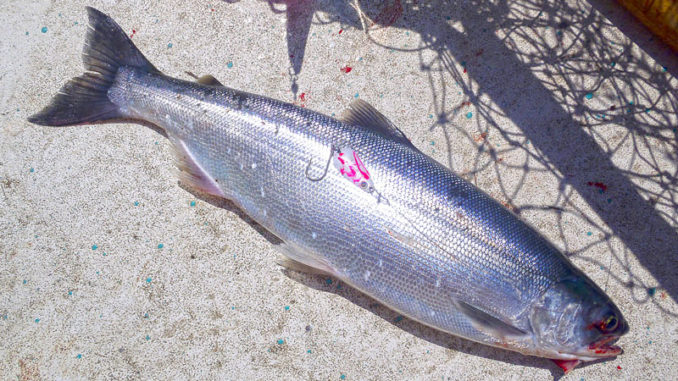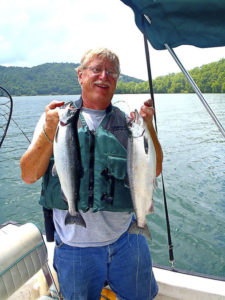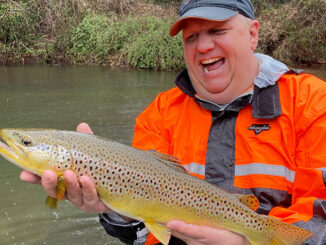
Kokanee salmon stockings are Nantahala Lake’s big experiment.
Nantahala Lake in the far-western North Carolina counties of Clay and Macon contains the usual assortment of gamefish — bass, walleye, trout and bream. But one exception makes it unique. Nantahala is the only lake in the Southeast with Kokanee salmon, a species more identified with far western and northern states.
Kokanee, a landlocked version of sockeye salmon, were stocked in the lake between 1959 and 1964, not as a gamefish but as a forage fish for predator species, primarily trout. After stockings ceased, the Kokanee survived, unexpectedly. And natural reproduction produced a new fishery, attracting a small but dedicated number of anglers.
In response to angler interest in continuing a Kokanee fishery, the N.C. Wildlife Resources Commission plans to resume stockings. Eggs from Montana, hatched at the Bobby Setzer State Fish Hatchery in Transylvania County, are now fingerling size. The Commission will stock approximately 30,000 Kokanee in Nantahala, which covers 1,600 acres.
5-year program
Biologist Amanda Bushon, who is coordinating the stocking program for the Commission, said stockings will continue on an experimental basis for five years. The program will then be evaluated to determine if it will continue.
Kokanee aren’t big fish; they average 9 to 12 inches and weigh about a pound, but 20-inch Kokanee in the 3-pound range are not uncommon. Nantahala has produced several Kokanee in the 4-pound range, including two state records set back-to-back. The current record is a 4.1-pound Kokanee caught in 2014 by Jeffery Todd Smith of Henderson County.
Bushon said the larger fish are likely a result of a low-density population and less competition for plankton, the Kokanee’s primary food source.
Shaped much like a trout, with long, slender bodies, Kokanee have blue backs and silver sides. Spawning is somewhat erratic and can occur anytime between August and February. Both the female and male turn blood red during the spawn. The female builds a redd, lays her eggs, the male fertilizes the eggs, and shortly after, both the male and female die. When eggs hatch and reach 2½ to 3 inches, the fingerlings migrate to the lake and reach adulthood in about four years, their average lifespan.

Quite a fight
The Commission’s restocking program is especially good news to anglers like Mark Swann of Black Mountain, N.C., who has been fishing the lake for more than a decade.
“They’re fun to catch,” he said, “and they are fantastic fighters.”
Because Kokanee aren’t surface feeders, Swann said the most-effective method of fishing for them is slow-trolling. After locating schooling Kokanee with his fish-finder, Swann uses a downrigger to position his rig among the fish. Kokanee respond to the rigs, not as a food source but as invading predators, and they attack the lure.
Standard baits rarely work because Kokanee don’t respond to lures imitating baitfish, because that’s not what they eat. Kokanee rigs are designed to attract the fish, not feed them. Standard Kokanee lures consist of a flasher or dodger with a lure attached to an 8- to 10-inch leader. The lure can be a simple spoon or one designed specifically for Kokanee such as the Wedding Band. The rigs emit flashes or vibrations that attract Kokanee.
An exception is lures tipped with commercial maggots or white shoe-peg corn. Corn kernels work best when attached with the open end of the kernel facing the hook.
Swann said he gets good results with corn. “For some reason, they like shoe peg corn,” he said.
Schooling salmon
Kokanee are primarily a schooling fish, usually found mid-lake.
“I’ve caught them at depths of 95 feet in the middle of the lake,” Swann said, who has also has caught them close to shorelines, always by the same method.
Kokanee have soft mouths, and it requires finesse to land one. Swann uses ultralight tackle and 4- to 5-pound test line.
Water temperature also is an important factor, Swann said. Kokanee are more active at water temperatures in the low 50s.
Nantahala Lake is ideal habitat for Kokanee because of its elevation (3,000 feet), ensuring a uniform, year-round temperature range in which Kokanee thrive, If the Kokanee experiment is successful at Nantahala, maybe Kokanee could be stocked in other environmentally suitable western North Carolina lakes.





Be the first to comment